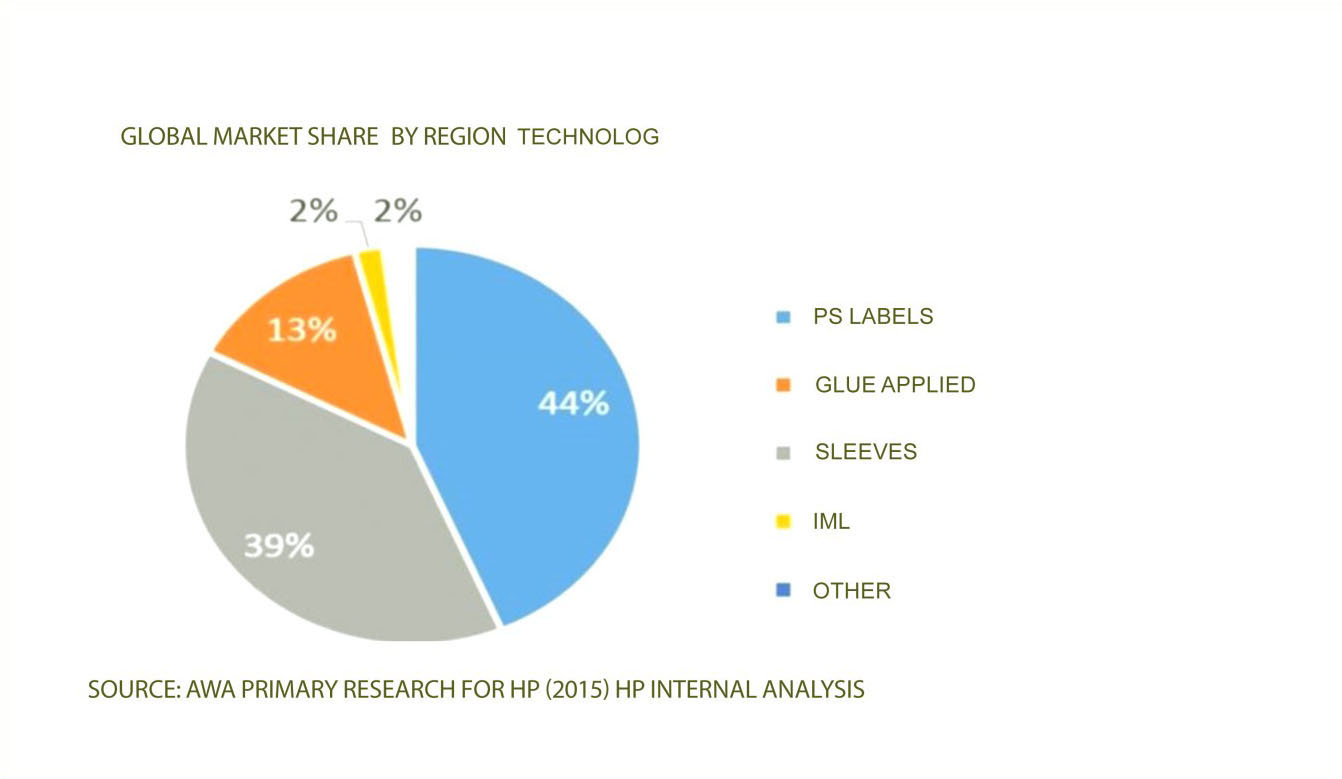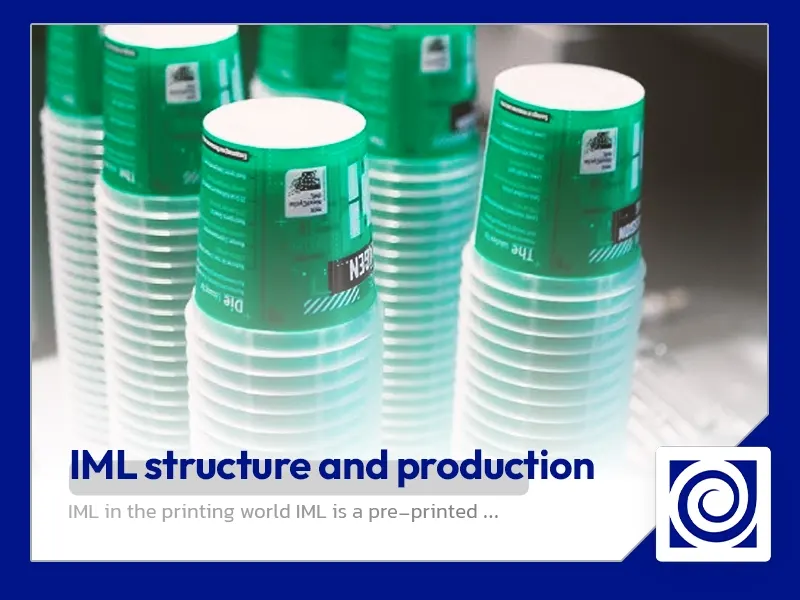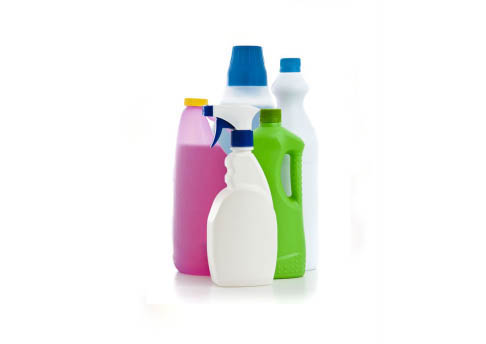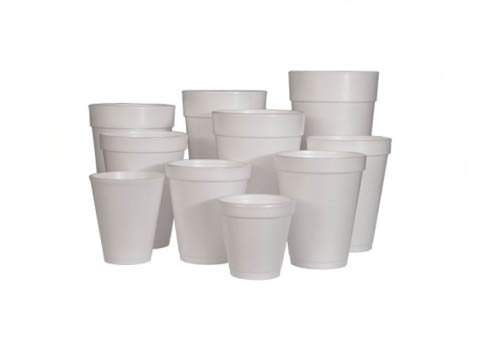IML in the printing world
IML is a pre-printed polypropylene (PP) label that is produced on plastic containers and buckets simultaneously with the injection process of these products. This mold has the shape of the final product and takes the shape of the mold during cooking. IML is a pre-printed polypropylene (PP) label that is produced on plastic containers and buckets simultaneously with the injection process of these products.
History of IML printing:
After years of researching and inventing various methods, one method stood out much more than others and attracted everyone’s attention. In this method, the label was placed inside the mold and at the same time as the container was produced, the printed label was also placed on the container, which is called (IML) In Mold Labeling. The invention of the IML method goes back to the early 1980s, which quickly gained popularity after its introduction to the packaging industry. Currently, more than 85% of food products are packed with the IML method, which shows its very high growth considering the youth of this method.
In North America, IML began its work in the detergent industry and was first used on injection molded plastic bottles. After that, and with better information about it, it was widely used in other industries, including the food industry.
Advantages of IML printing
1- The maximum quality of offset printing:
Currently, IML offset printing is known as the highest quality type of printing. In offset printing, we can print trams on the IML surface with very high precision.
2- EML printing, strong and hygienic:
IML resists humidity and temperature changes, and is also the best solution for decorating plastic containers for frozen and refrigerated products. IMLs are also scratch resistant and resistant to cracking and wrinkling.
3- Reducing the cost of production with IML printing:
Compared to other types of labels, IML costs much less, both in terms of the price of the product itself and in terms of labor costs. Because the labeling operation is done automatically by the machine and does not have separate labor costs, and as a result, the price of IML will be more affordable.
4- Reducing production time with IML printing:
The high speed of IML offset printing is very high compared to other methods, including printing on plastic, labeling. In addition, due to the labeling operation at the same time as the production of the IML container, the time spent on labeling is reduced to zero.
5- Environmentally friendly IML printing:
Format labeling in IML printing is very environmentally friendly, IML packaging and labels are made of the same type of material, so they can be recycled simultaneously and completely with each other, and compared to paper labels, there is no need for recycling. There is no separation of the label from the container, and as a result, IML is more compatible with the environment.
6- Fast design change:
Offset printing systems make it possible to change the design on the IML label in the shortest possible time, make a new zinc based on the desired print and start the new IML printing. This is considered a significant advantage compared to plastic printing and other types of printing.
7- IML look and feel options:
IML offers many visual and aesthetic possibilities and allows for a wide range of plastic packaging solutions, including yogurt bucket labels, paint bucket labels, oil bucket labels, using different combinations of IML substrates, inks and varnishes. Create labels for cheese containers and other containers.
IML production and printing process
The IML production process is usually done by several companies, starting from the IML production printing house with IML printing. Here, IMLs are printed by the most advanced UV and metallization printing machines, the ink is also protected with a glossy or colored layer, and the printed IMLs are cut according to the template. The cut IMLs are then transported to the container manufacturer for the molding process. After the IML container or IML bucket is molded with a label, it is transferred for filling.
With the invention of this method, today most producers of yogurt buckets, paint buckets, cheese containers and other containers benefit from this method instead of using laser or adhesive back labels. They easily put a label in the mold and inject the material behind it, and in this way, the 3 processes of label production, sticking the label and sticker on the container and producing the container are all done in one step.
Types of IML container
A- Plastic injection
B- Air injection
C- Thermal forming or thermoforming (IML)
In monitoring the share of this technology in the use of IML, it should be said that plastic injection is the most common method with almost 68%, after that pneumatic injection has 31% and thermoforming has the lowest share of 1%.
A- Plastic injection Bold,
The process of injection molding is based on injecting materials into the mold. This method is done with warm polymers. During the injection molding process, a heated liquid mass is injected into the mold under high pressure. Then it is cooled and solidified in the form of a mold. Injection molding in IML means that the formation of the product takes place inside the IML mold. During this process, the printed IML label is first placed in the mold, and then the molten polymer is injected into the mold, and after the polymer is formed and cooled, finally a one-piece product is decorated with the label in a The step produced is obtained. The IML label is usually used for 20-liter oil buckets, paint buckets in various weights, 1 kg yogurt buckets, yogurt bucket lids, cheese containers, ice cream containers, butter containers, and many food and chemical industries.
The injection molding process includes the following steps:
- The cut label is placed in the mold.
- The mold is closed and the molten polymer is injected into the mold from the extruder. The label is homogenized with plastic.
- The plastic is cooled, the mold is opened, and the container is prepared with the label attached to its surface.
The above steps can be seen in the figure below:
B- Air injection: bold,
Air molding is a method used to produce hollow plastic parts. In this method, the pre-printed IML is placed inside the steel mold. Then the heated plastic material goes into the mold and the two parts of the mold are closed on it, and with the blowing of hot air and high pressure, the stretched plastic is shaped into a mold, and the IML label will also be mixed with the surface and placed on it. . This technology is used in the preparation of shampoo container, powder container, dishwashing liquid container, 4 liter oil container and in many chemical industries. This method has not been used in Iran yet, but investing in it can have a bright future.
The process of air molding includes the following steps:
- The cut IML label is placed inside the walls of the mold.
- Vacuum suction holds the IML in place.
- The mold is closed and by blowing hot air with high pressure, the piece takes the shape of the IML mold and the label embedded in the wall of the mold is attached to the surface of the product.
- After cooling, the mold is opened and the part falls out with IML.
These steps can be seen in the figure below:

C- Thermoforming (TIML) Bold,
Thermoforming is a method used to produce rigid plastic packaging. This process is based on heating the TIML and allows the TIML to take the shape of a forming tool. When the plastic cools, it solidifies into the shape of the forming tool. Thermoforming is often used to produce barrier packages. In this case, the multilayered sheets become closed and prevent the entry of oxygen. Thermoforming IML or TIML means that the shape of the product takes place during the heating process. The IML label, which is injected into the forming tool before forming, is fused to the heated plastic sheet when the final package is formed.
The thermal process includes the following steps:
- The cut TIML is placed in the mold.
- The thermoplastic sheet is heated before entering the mold. The heated plastic sheet is gently inserted, the mold is closed, it is shaped; TIML integrates with plastic.
- The plastic is cooled and the mold is opened and the product comes out with the label.
These steps can be seen in the figure below.
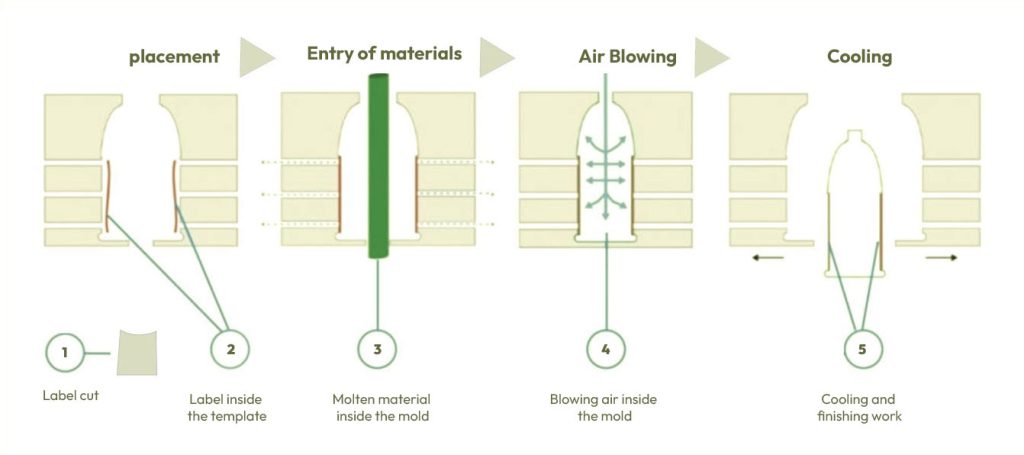
IML and product marketing
IML labels are highly resistant to heat and cold, and even containers with this type of label can be used in the microwave. Due to the very high durability of the label and design on the IML container and the ability to reuse the packaging container several times after using the primary product, advertising and marketing operations are also carried out automatically and for a longer period of time. This means completely free advertising, which is the result of IML technology. Currently, the IML consumption market is increasing rapidly in the world, and the owners of different brands in different fields of production are finding new ways to use it to offer their products as well as possible.
Even companies producing paint and resin, chemical products used in swimming pools, all kinds of fruit drinks and finally all kinds of dairy products have started using the attractive and affordable IML method. As can be seen from the mentioned examples, there is no limit to the use of IML in the packaging industry, and almost any product can be packaged and marketed using IML. Some experts consider IML to be everything, because just by changing the type of packaging to IML, a company can achieve several important goals, including differentiation in appearance, doing marketing automatically and without spending a minimum amount of money. Additional and finally unique beauty with very natural and varied colors.
A bright future for IML packaging:
There is currently a high demand for IML containers in the plastic packaging container market and this demand is increasing. The transition from paper labels to IML labels has been underway for several years and is expected to continue rapidly in the future. Special films for IML labels account for 80% (dollar value) of the entire world IML market, and it is expected that the use of injection molding to produce IML containers in the next few years will be the largest growth of this market in the world. to dedicate IML technology owes part of its growth to the aesthetic aspects and quality of IML printing; Product suppliers need more beautiful and impressive labels and containers to ensure that their message is delivered to the consumer; As long as this demand exists, the IML market will continue to grow.
